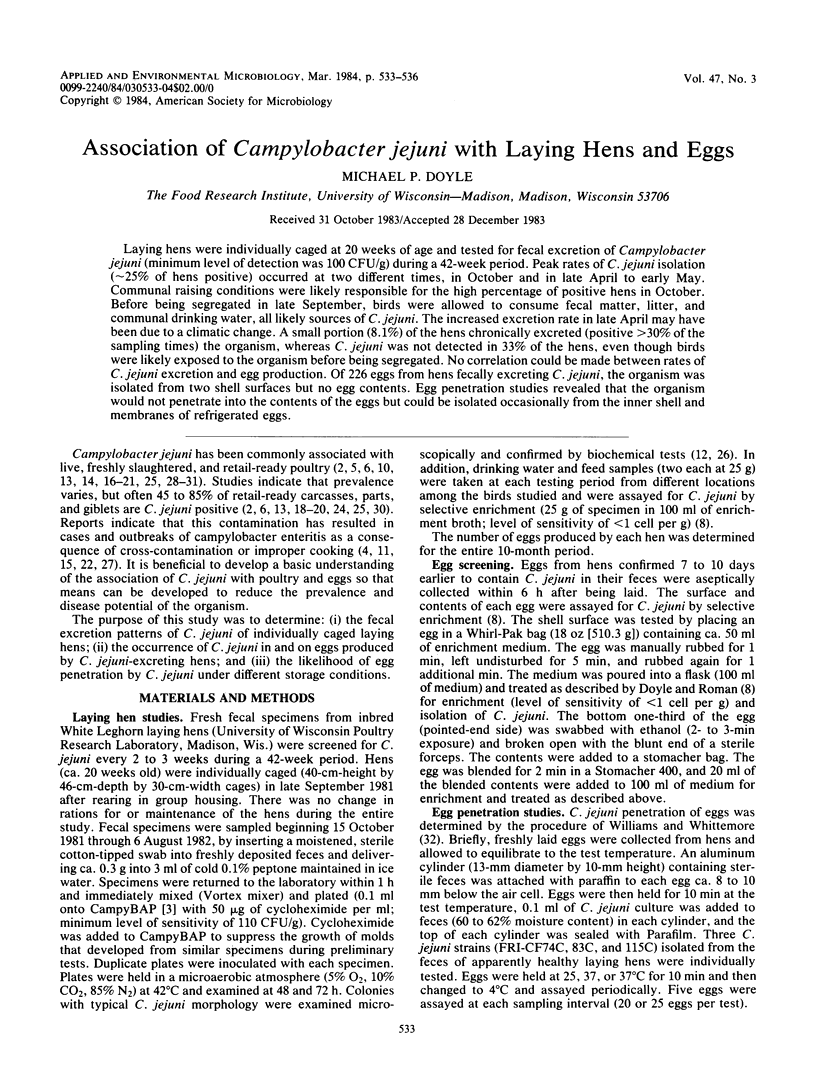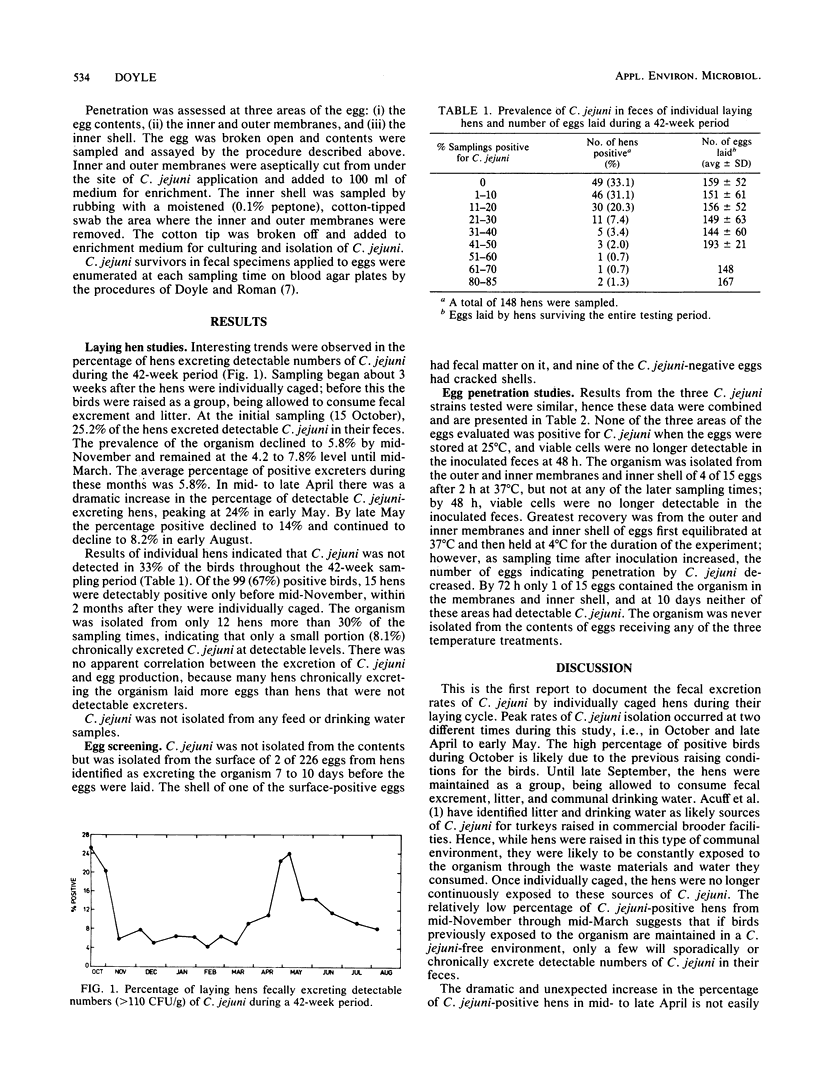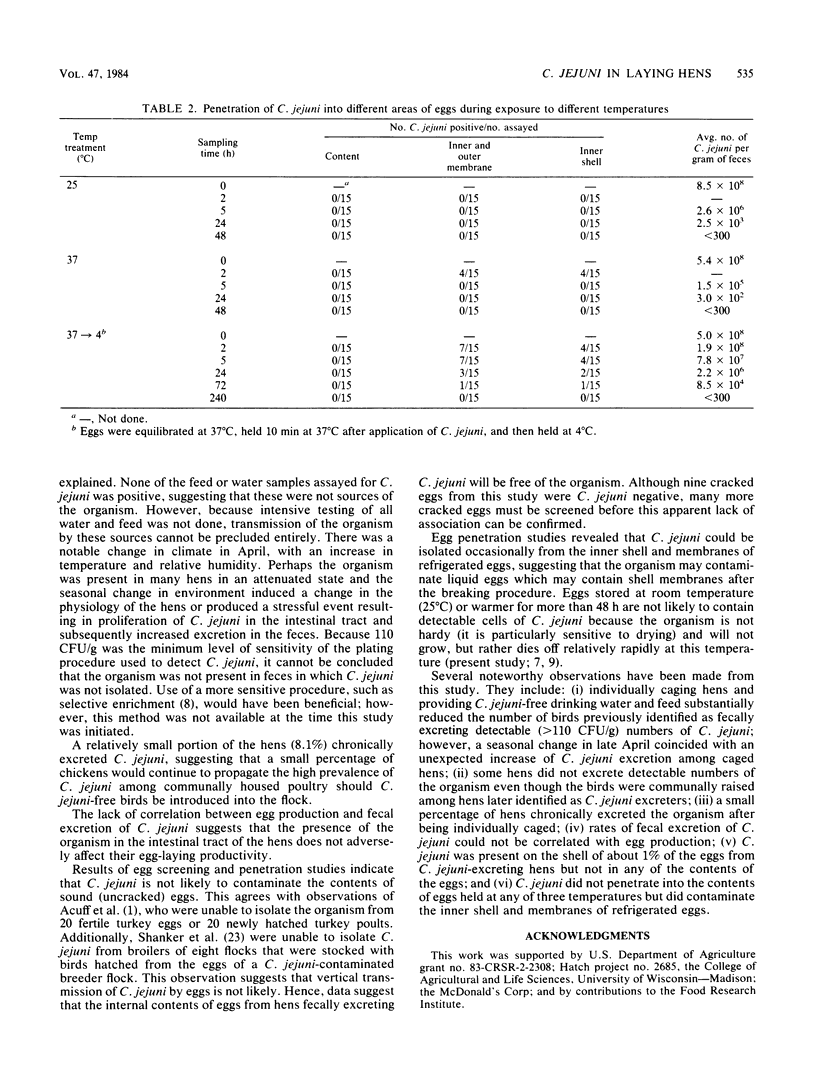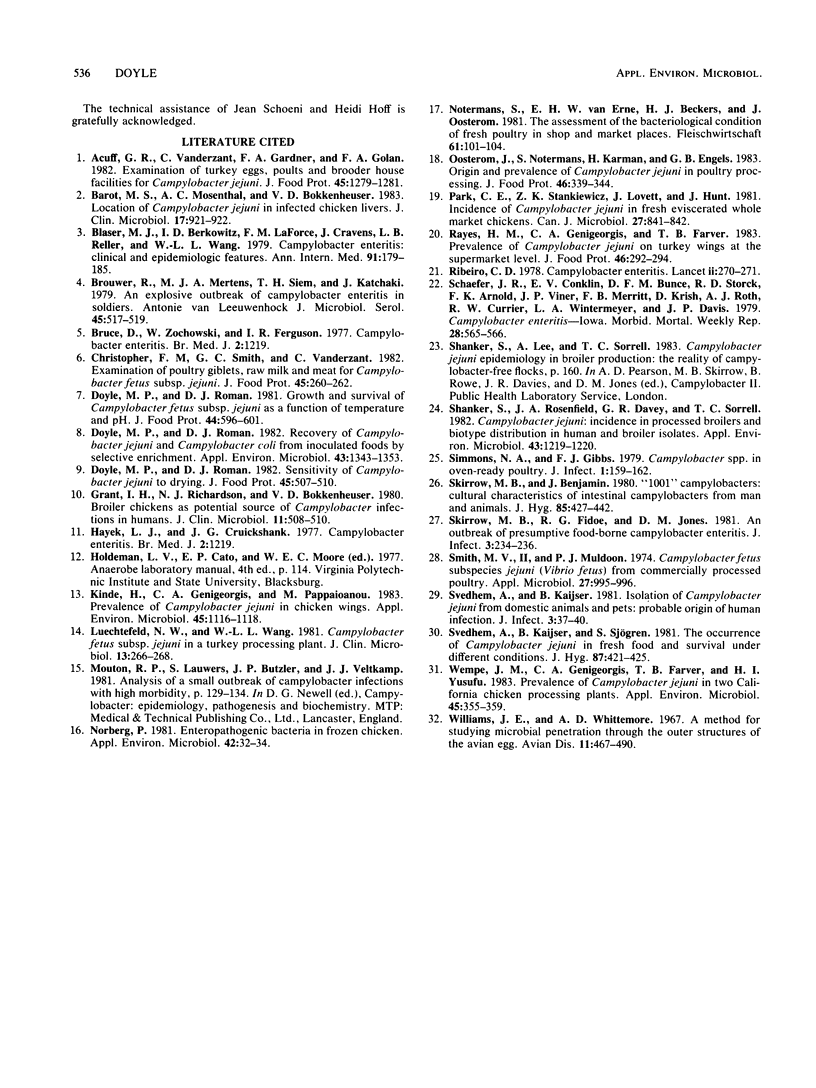Abstract
Laying hens were individually caged at 20 weeks of age and tested for fecal excretion of Campylobacter jejuni (minimum level of detection was 100 cfu/g) during a 42-week period. Peak rates of C. jejuni isolation (approximately 25% of hens positive) occurred at two different times, in October and in late April to early May. Before being segregated in late September, birds were allowed to consume fecal matter, litter, and communal drinking water, all likely sources of C. jejuni. The increased excretion rate in late April may have been due to a climatic change. A small portion (8.1%) of the hens chronically excreted (positive less than 30% of the sampling times) the organism, whereas C. jejuni was not detected in 33% of the hens, even though birds were likely exposed to the organism before being segregated. No correlation could be made between rates of C. jejuni excretion and egg production. Of 266 eggs from hens fecally excreting C. jejuni, the organism was isolated from two shell surfaces but no egg contents. Egg penetration studies revealed that the organism would not penetrate into the contents of the eggs but could be isolated occasionally from the inner shell and membranes of refrigerated eggs.
Full text
PDF



Selected References
These references are in PubMed. This may not be the complete list of references from this article.
- Barot M. S., Mosenthal A. C., Bokkenheuser V. D. Location of Campylobacter jejuni in infected chicken livers. J Clin Microbiol. 1983 May;17(5):921–922. doi: 10.1128/jcm.17.5.921-922.1983. [DOI] [PMC free article] [PubMed] [Google Scholar]
- Blaser M. J., Berkowitz I. D., LaForce F. M., Cravens J., Reller L. B., Wang W. L. Campylobacter enteritis: clinical and epidemiologic features. Ann Intern Med. 1979 Aug;91(2):179–185. doi: 10.7326/0003-4819-91-2-179. [DOI] [PubMed] [Google Scholar]
- Brouwer R., Mertens M. J., Siem T. H., Katchaki J. An explosive outbreak of Campylobacter enteritis in soldiers. Antonie Van Leeuwenhoek. 1979;45(3):517–519. doi: 10.1007/BF00443293. [DOI] [PubMed] [Google Scholar]
- Doyle M. P., Roman D. J. Recovery of Campylobacter jejuni and Campylobacter coli from inoculated foods by selective enrichment. Appl Environ Microbiol. 1982 Jun;43(6):1343–1353. doi: 10.1128/aem.43.6.1343-1353.1982. [DOI] [PMC free article] [PubMed] [Google Scholar]
- Grant I. H., Richardson N. J., Bokkenheuser V. D. Broiler chickens as potential source of Campylobacter infections in humans. J Clin Microbiol. 1980 May;11(5):508–510. doi: 10.1128/jcm.11.5.508-510.1980. [DOI] [PMC free article] [PubMed] [Google Scholar]
- Kinde H., Genigeorgis C. A., Pappaioanou M. Prevalence of Campylobacter jejuni in chicken wings. Appl Environ Microbiol. 1983 Mar;45(3):1116–1118. doi: 10.1128/aem.45.3.1116-1118.1983. [DOI] [PMC free article] [PubMed] [Google Scholar]
- Luechtefeld N. W., Wang W. L. Campylobacter fetus subsp. jejuni in a turkey processing plant. J Clin Microbiol. 1981 Feb;13(2):266–268. doi: 10.1128/jcm.13.2.266-268.1981. [DOI] [PMC free article] [PubMed] [Google Scholar]
- Norberg P. Enteropathogenic bacteria in frozen chicken. Appl Environ Microbiol. 1981 Jul;42(1):32–34. doi: 10.1128/aem.42.1.32-34.1981. [DOI] [PMC free article] [PubMed] [Google Scholar]
- Park C. E., Stankiewicz Z. K., Lovett J., Hunt J. Incidence of Campylobacter jejuni in fresh eviscerated whole market chickens. Can J Microbiol. 1981 Aug;27(8):841–842. doi: 10.1139/m81-129. [DOI] [PubMed] [Google Scholar]
- Ribeiro C. D. Campylobacter enteritis. Lancet. 1978 Jul 29;2(8083):270–271. doi: 10.1016/s0140-6736(78)91789-0. [DOI] [PubMed] [Google Scholar]
- Shanker S., Rosenfield J. A., Davey G. R., Sorrell T. C. Campylobacter jejuni: incidence in processed broilers and biotype distribution in human and broiler isolates. Appl Environ Microbiol. 1982 May;43(5):1219–1220. doi: 10.1128/aem.43.5.1219-1220.1982. [DOI] [PMC free article] [PubMed] [Google Scholar]
- Skirrow M. B., Benjamin J. '1001' Campylobacters: cultural characteristics of intestinal campylobacters from man and animals. J Hyg (Lond) 1980 Dec;85(3):427–442. doi: 10.1017/s0022172400063506. [DOI] [PMC free article] [PubMed] [Google Scholar]
- Skirrow M. B., Fidoe R. G., Jones D. M. An outbreak of presumptive food-borne campylobacter enteritis. J Infect. 1981 Sep;3(3):234–236. doi: 10.1016/s0163-4453(81)90819-7. [DOI] [PubMed] [Google Scholar]
- Smith M. V., 2nd, Muldoon P. J. Campylobacter fetus subspecies jejuni (Vibrio fetus) from commercially processed poultry. Appl Microbiol. 1974 May;27(5):995–996. doi: 10.1128/am.27.5.995-996.1974. [DOI] [PMC free article] [PubMed] [Google Scholar]
- Svedhem A., Kaijser B. Isolation of Campylobacter jejuni from domestic animals and pets: probable origin of human infection. J Infect. 1981 Mar;3(1):37–40. doi: 10.1016/s0163-4453(81)92261-1. [DOI] [PubMed] [Google Scholar]
- Svedhem A., Kaijser B., Sjögren E. The occurrence of Campylobacter jejuni in fresh food and survival under different conditions. J Hyg (Lond) 1981 Dec;87(3):421–425. doi: 10.1017/s0022172400069667. [DOI] [PMC free article] [PubMed] [Google Scholar]
- Wempe J. M., Genigeorgis C. A., Farver T. B., Yusufu H. I. Prevalence of Campylobacter jejuni in two California chicken processing plants. Appl Environ Microbiol. 1983 Feb;45(2):355–359. doi: 10.1128/aem.45.2.355-359.1983. [DOI] [PMC free article] [PubMed] [Google Scholar]
- Williams J. E., Whittemore A. D. A method for studying microbial penetration through the outer structures of the avian egg. Avian Dis. 1967 Aug;11(3):467–490. [PubMed] [Google Scholar]


